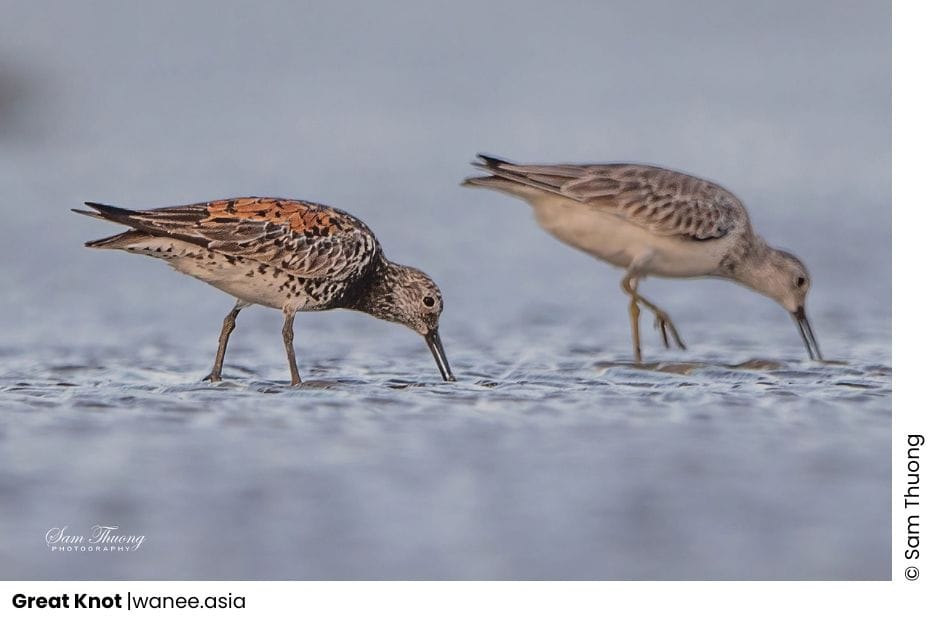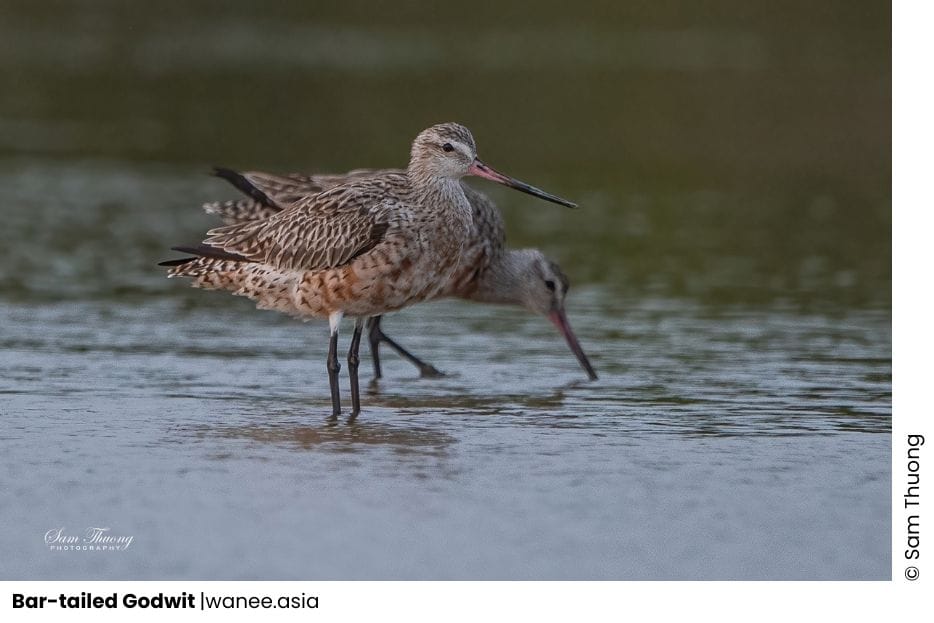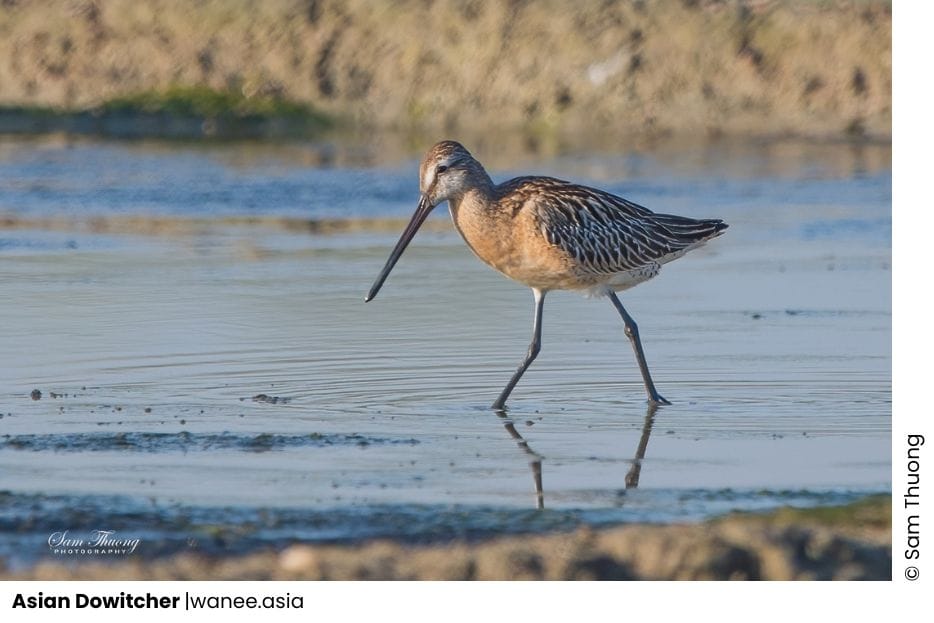Sandpipers & Allies Of Vietnam – Scolopacidae
With 40 species of Sandpipers & Allies Of Vietnam, occurring over the country, some species really hard to see. Most of them are shorebirds that migrate throughout more than 5400km of the coastline of Vietnam Far Eastern Curlew, Great Knot and Nordman’s Greenshank are three species that have the status Endangered species on IUCN red list. Especially, Vietnam is honored to have a starlight visitor of migration shorebirds Spoon-billed Sandpiper a Critically Endangered species that all birder want to see or take pictures of when visiting Vietnam.
You may know: Mention Vietnam Shorebirds to anyone who has spent time birding in the country or is perhaps planning a birding trip to Vietnam in the future and the names of two particular bird families will surely come up, Sandpiper & Plover.
The overview of Sandpipers & Allies families
Sandpipers are a large family, Scolopacidae, of waders. They include many species called sandpipers, as well as those called by names such as Curlew and Snipe. The majority of these species eat small invertebrates picked out of the mud or soil. Different lengths of bills enable different species to feed in the same habitat, particularly on the coast, without direct competition for food.
Sandpipers have long bodies and legs, and narrow wings. Most species have a narrow bill, but otherwise the form and length are quite variable. They are small to medium-sized birds, measuring 12 to 66 cm (4.7–26.0 in) in length. The bills are sensitive, allowing the birds to feel the mud and sand as they probe for food. They generally have dull plumage, with cryptic brown, grey, or streaked patterns, although some display brighter colours during the breeding season.
Most species nest in open areas, and defend their territories with aerial displays. The nest itself is a simple scrape in the ground, in which the bird typically lays three or four eggs. The young of most species are precocial.
Many Sandpipers form monogamous pairs, but some sandpipers have female-only parental care, some male-only parental care, some sequential polyandry and other compete for the mate on the lek. Sandpipers lay three or four eggs into the nest, which is usually a vague depression or scrape in the open ground, scarcely lined with soft vegetation. In species where both parents incubate the eggs, females and males share their incubation duties in various ways both within and between species.
In some pairs, parents exchange on the nest in the morning and in the evening so that their incubation rhythm follows a 24-hour day, in others each sex may sit on the nest continuously for up to 24 hours before it is exchanged by its partner. In species where only a single parent incubates the eggs, during the night the parent sits on the eggs nearly continuously and then during the warmest part of a day leaves the nest for short feeding bouts. Chicks hatch after about three weeks of incubation and are able to walk and forage within a few hours of hatching. A single parent or both parents guide and brood the chicks.
Are you looking for Wildlife Tours in Vietnam?
WANEE VIETNAM is your go-to destination for "Wildlife Tours in Vietnam", specializing in Birding, Primate Watching, Herping, Photography Tours and Educational Tours led by our expert guides.Sandpipers & Allies of Vietnam Highlight note

Spoon-billed Sandpiper Eurynorhynchus pygmeus
Status: Especially Rare Pass Migrant – Critically Endangered Species
Best time to watch & Photo: Nov – Apr
Tours: Coastline Vietnam
Hotspot: LaGi, Can Gio, Binh Dai, Go Cong

Great Knot Calidris tenuirostris
Status: Rare Pass Migrant – Endangered Species
Best time to watch & Photo: Nov – Apr
Tours: Mekong Delta
Hotspot: Can Gio, Xuan Thuy, Go Cong

Far Eastern Curlew Numenius madagascariensis
Status: Rare Pass Migrant – Endangered Species
Best time to watch & Photo: Nov – Apr
Tour cover: Coastline Vietnam
Hotspot: Can Gio, Xuan Thuy, Go Cong

Nordmann’s Greenshank Tringa guttifer
Status: Rare Pass Migrant – Endangered Species
Best time to watch & Photo: Nov – Apr
Tours: Mekong Delta
Hotspot: Can Gio, Go Cong.

Black-tailed Godwit Limosa limosa
Status: Rare Pass Migrant – Near Threatened
Best time to watch & Photo: Nov – Apr
Tours: Coastline South of Central Vietnam
Hotspot: LaGi, Xuan Thuy

Eurasian Curlew Numenius arquata
Status: Rare Pass Migrant – Near Threatened
Best time to watch & Photo: Feb-Apr
Tours: Coastline Vietnam
Hotspot: Can Gio, Go Cong

Bar-tailed Godwit Limosa lapponica
Status: Uncommon Pass Migrant – Near Threatened
Best time to watch & Photo: Nov – Apr
Tours: Coastline Vietnam
Hotspot: Can Gio, Xuan Thuy, Go Cong

Asian Dowitcher Limnodromus semipalmatus
Status: Uncommon Pass Migrant – Near Threatened
Best time to watch & Photo: Nov – Apr
Tours: Plains Vietnam
Hotspot: Can Gio, Xuan Thuy, Go Cong

Red-necked Stint Calidris pygmaea
Status: Uncommon Pass Migrant – Near Threatened
Best time to watch & Photo: Nov – Apr
Tour: Coastline Vietnam
Hotspot: Can Gio, Xuan Thuy, Go Cong
List of all Sandpipers in Vietnam
| Name | Level | |
| 1 | Whimbrel | Easy |
| 2 | Far Eastern Curlew | Hard |
| 3 | Eurasian Curlew | Easy |
| 4 | Bar-tailed Godwit | Maybe |
| 5 | Black-tailed Godwit | Maybe |
| 6 | Ruddy Turnstone | Easy |
| 7 | Great Knot | Easy |
| 8 | Red Knot | Easy |
| 9 | Ruff | Hard |
| 10 | Broad-billed Sandpiper | Easy |
| 11 | Sharp-tailed Sandpiper | Maybe |
| 12 | Curlew Sandpiper | Easy |
| 13 | Temminck’s Stint | Easy |
| 14 | Long-toed Stint | Easy |
| 15 | Spoon-billed Sandpiper | Hard |
| 16 | Red-necked Stint | Easy |
| 17 | Sanderling | Maybe |
| 18 | Dunlin | Easy |
| 19 | Little Stint | Easy |
| 20 | Pectoral Sandpiper | Hard |
| 21 | Asian Dowitcher | Maybe |
| 22 | Long-billed Dowitcher | Hard |
| 23 | Jack Snipe | Hard |
| 24 | Eurasian Woodcock | Maybe |
| 25 | Solitary Snipe | Hard |
| 26 | Wood Snipe | Hard |
| 27 | Common Snipe | Maybe |
| 28 | Pin-tailed Snipe | Easy |
| 29 | Swinhoe’s Snipe | Hard |
| 30 | Terek Sandpiper | Easy |
| 31 | Red-necked Phalarope | Maybe |
| 32 | Common Sandpiper | Easy |
| 33 | Green Sandpiper | Hard |
| 34 | Gray-tailed Tattler | Maybe |
| 35 | Spotted Redshank | Maybe |
| 36 | Common Greenshank | Easy |
| 37 | Nordmann’s Greenshank | Hard |
| 38 | Marsh Sandpiper | Easy |
| 39 | Wood Sandpiper | Easy |
| 40 | Common Redshank | Easy |
Note: Hard – Really hard to see; Maybe – …..; Easy – Easy to see with guide; Impossible – Weak info; Lack Data – Consider out of list
Crocodile Trail – The Best Birding Trail in Cat Tien National Park
If you’re a birder or nature photographer planning a trip to Vietnam, few places offer [...]
Cong Troi Trail – Top 1 Dalat Plateau Birding Trail Experience
If you’re a birder or nature photographer planning a trip to Vietnam’s Central Highlands, the [...]
How to Identify the Greater Sand Plover, Tibetan Sand Plover and Siberian Sand Plover
ContentsSandpipers & Allies Of Vietnam – ScolopacidaeSandpipers & Allies of Vietnam Highlight noteAll Vietnam Birds [...]
Highlights of Cat Tien National Park Reptiles and Amphibian Endemics
Spanning over 71,350 hectares of tropical forests, grasslands, and wetlands, Cat Tien National Park is [...]
Highlights of Cat Tien National Park Mammals in a World Biosphere Reserve
In addition to reptiles and birds, Cat Tien National Park is also rich in mammals, [...]
Kontum Plateau Endemic and Highlight bird
Kontum Plateau Endemic And Highlight Bird species like Chestnut-eared Laughingthrush and top birding routes while [...]